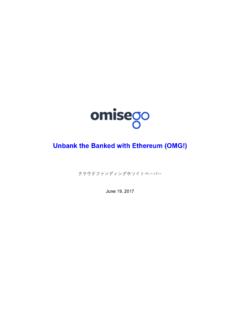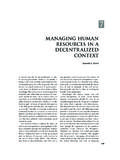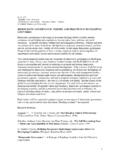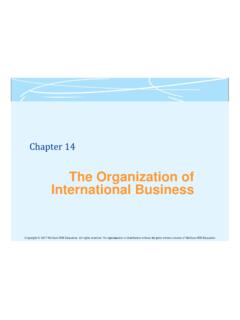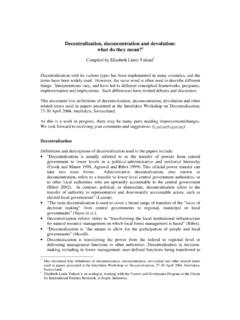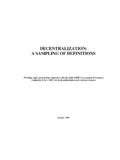Transcription of OmiseGO
1 OmiseGODecentralized Exchange and Payments PlatformJoseph 17, 2017 AbstractOmiseGO is building a decentralized exchange, liquidity provider mechanism, clear-inghouse messaging network, and asset-backed blockchain gateway. OmiseGO is notowned by any single one party. Instead, it is an open distributed network of validatorswhich enforce behavior of all participants. It uses the mechanism of a protocol tokento create a proof-of-stake blockchain to enable enforcement of market activity amongstparticipants. This high-performant distributed network enforces exchange across as-set classes, from fiat-backed issuers to fully decentralized blockchain tokens (ERC-20style and native cryptocurrencies). Unlike nearly all other decentralized exchange plat-forms, this allows for decentralized exchange of other blockchains and between multipleblockchains directly without a trusted gateway token. Markets may be able to signifi-cantly reduce spreads and encourage market assurance via decentralizing custody andincreased transparency of market activity.
2 This is achieved using smart contracts, proto-col tokens enforcing correct market behavior of orderbook matching, a new constructionof Ethereum bonded external enforcement of clearinghouse activity, and commitmentsto historical exchange data for use with Ethereum smart Introduction and Problem StatementThe primary role of blockchains are to solve coordination problems among multilateralagreements between a network of participants. By ensuring transparency, assurance, andenforcement, we can enable multilateral agreements where they were not previously all parties are assured that the operations are not only transparent, but also themechanisms are guaranteed to not change without significant effort, parties are more willingto coordinate. Participants have significantly higher guarantees that a single party hasdifficulty forcing other parties in the future into usurious rent extraction via a change inbusiness processes or information asymmetry.
3 In other words, any single participant is morewilling to use systems where the business processes and mechanisms itself are not ownedby any other single is a fundamental coordination problem amongst payment processors, gateways,and financial institutions. For instance, a customer of a bank wishes to pay a merchant on1another network. Traditionally, there have been significant efforts in engineering aroundpayment systems which are compatible across payment networks and financial are usually constructed by creating a clearinghouse which manages the interchange,usually via a messaging network with either a central counterparty clearinghouse or nos-tro/vostro accounts. Examples include FedWire, CHIPS, SWIFT, consumer card paymentnetworks, NSCC/DTCC, OCC, and ACH. These networks service different roles and func-tions, including local/national payments, international payments, credit, equities/asset ex-change, and derivatives. These centralized networks allow for the controlling entity toarbitrarily change the mechanisms, which result in significant amount of transaction costsvia information costs, due diligence, and contractual enforcement between all believe that there is currently a large emerging market of disruption in digital pay-ments with new payment platforms ( Venmo, Alipay, etc.)
4 These networks have signifi-cant aversion to interchange across networks, as it usually requires significant overhead costsin trust with the interchange facility. Parties are unwilling to use central counterparties, asneither party wishes to defer to the other, and use of nostro/vostro accounts require bespokecontracts between participants. While the larger networks have significant incentive aroundprotection of their network effects, we believe that there is a long-tail of entities wishingto provide eWallet services which require greater coordination amongst multilateral partic-ipants. These mid-size participants will be able to cross value across networks in order toreach sufficient network effects in usability. The infrastructure and reference frontend forthese providers will allow for the network effects to be encoded into this network, allowingfor emerging eWallet participants to instantly create high network allows society to externalize the world s business processes from single cen-tralized corporations into open, decentralized computing networks.
5 [1][2] OmiseGO (OMG)is a network which decentralizes market liquidity, orderbook matching and execution, clear-inghouse custodianship, and high-scalability payments to help resolve payments across theseemerging eWallet payment shifting these business processes traditionally placed into a single corporation, itis possible to provide eWallet providers an entire interchange process in a decentralizedhigh-performant open Design ApproachThe end-state requirement is a construction of a decentralized mechanism for eWallet plat-forms holding fiat-backed value (as well as native, opt-in, support for cryptocurrencies).The eWallet fiat tokens will have the ability to use Ether on the decentralized , publicEthereum[3][4] chain (or any other decentralized cryptocurrency) as the interchange/in-termediary cross for maximum efficiency. We believe that this allows for significant moreactivity and value in decentralized cryptocurrencies, as it will serve as a useful venue formany eWallet it s a core function for this decentralized network to do eWallet interchange, a2blockchain ledger on OmiseGO is necessary to hold the general balance of funds per eWalletservice (or any user/node).
6 This ledger must be able to hold funds across many assets/com-modities. However, merely holding a ledger is insufficient for interchange. The mechanismmust also allow to trade these order to perform interchange, it requires an order to be placed across many differentpairs on an open public market. This requires a decentralized orderbook and trading trading engine is built into the OMG blockchain, orders are published and matches areperformed as part of every block when a matched order has reached sufficient number ofvalidation confirmations. This results in a non-custodial decentralized exchange held bya single party where the eWallet platforms may exchange onto other eWallet platformswithout centralized trust on a single , direct crosses between eWallet fiat tokens may not be desirable, as there maybe too many. It would be necessary to use cryptocurrency for a liquid market withoutsingle preference.
7 By bonding Ethereum into a smart contract [5] (or Bitcoin-like tokensinto bonded clearinghouses), it is possible to lock up Ether onto the activity of the OMGchain to allow for eWallet pairs to occur over Ether or other cryptocurrencies, creating aliquid market (if every pair crosses with ETH, spreads would be much smaller providedlow currency volatility). For activity requiring very small spreads, it may emerge thatsome eWallet tokens will be used as interchange crossing; however, there s strong incentiveto use decentralized tokens for settlement due to coordination/trust advantages related toprogrammatic adjudication. eWallet fiat tokens may also cross using other eWallet tokensif necessary, but bonding which don t affect short-term exchange rate fluctuations of smartcontract activity will be primarily in ETH ( HTLC clearinghouse, liquidity providing,and OMG chain enforcement). By allowing for cryptocurrencies to be the backing foreWallet platforms, the platforms can be assured of an even playing field between eWalletinterchange requires a greater degree of liquidity in funds locked up, and the OmiseGO decen-tralized exchange may not be desirable to transact for low-value interchange activity ( high-volume micropayments).
8 Not every payment between two distinct eWallets must be performed using a trade onthe decentralized exchange. There is an expectation, that eWallets will hold some reserveof fiat tokens of other eWallets, ready to be used for smaller transfers in popular such as Lightning Network[6] allow for payments to occur off-chain wheneWallets hold balances to facilitate rapid payments. Implementations allow for paymentsacross Bitcoin[7] and Ethereum[8], which can be easily ported to the OMG chain for result of the OmiseGO blockchain construction is it allows for eWallet interchange,supported by a decentralized exchange, cryptocurrency ( ETH) matching, orderbook,and clearinghouses without full-custody decentralized Liquidity Hub for ChannelsThe construction has the additional benefit of allowing for a decentralized liquidity pool tobe created for use with payment channels on various cryptocurrencies, such as Bitcoin (andto some extent Ethereum).
9 For individual token payments on blockchains, there is a need to scale the underlyingblockchain activity which does not affect the underlying chain to reduce computationalpressure of validating/mining nodes. It is therefore necessary to conduct Lightning Net-work activities (or similar constructions using channels). However, Lightning Network facessignificant pressure around network effects with capital, it s desirable to prevent liquiditypools from centralizing to a single trusted entity. By using the same mechanisms of the de-centralized clearinghouse, we can create a Lightning Network hub which is not owned by anysingle individual on tokens which support more complex smart contracts ( Ethereum,ERC-20-like tokens, etc.). For currencies with simple smart contracts, any node on thenetwork ( Bitcoin network) can act as a gateway into the OMG chain pool and crossback with any other participant. This allows the OmiseGO chain to offload a lot of on-chainactivity, while encouraging believe that the natural network effects of liquidity centralization can be mitigatedby decentralized stake-chains with deterministic/known consensus Ethereum in particular (and other full-featured smart-contract scriptingblockchains), all participants set up channels into an ETH smart contract operatingas a single pool of funds.
10 The chain state of the OMG chain reflects the current balanceof participants. This allows for any participant to supply liquidity onto this networkwhich can be allocated in accordance to the OMG-chain consensus rules (limits may be inplace early on to prevent this blockchain from sucking up all the spare liquidity from thecryptocurrency space if this construction is successful before robust testing/validation overtime). These funds can thereby be used for any liquidity activity on the OMG Blockchain Overview and MechanismThe above mechanisms require significant volume of activity (with a large amount of state),and is not at this time suitable for all activity to occur on the Ethereum main chain,however the construction would be to bond trading activity in the public Ethereum chainwith contract execution input being provided by the OMG are building a blockchain which hooks into other blockchains to allow for tradingacross token/asset classes, largely backed by Ether.
